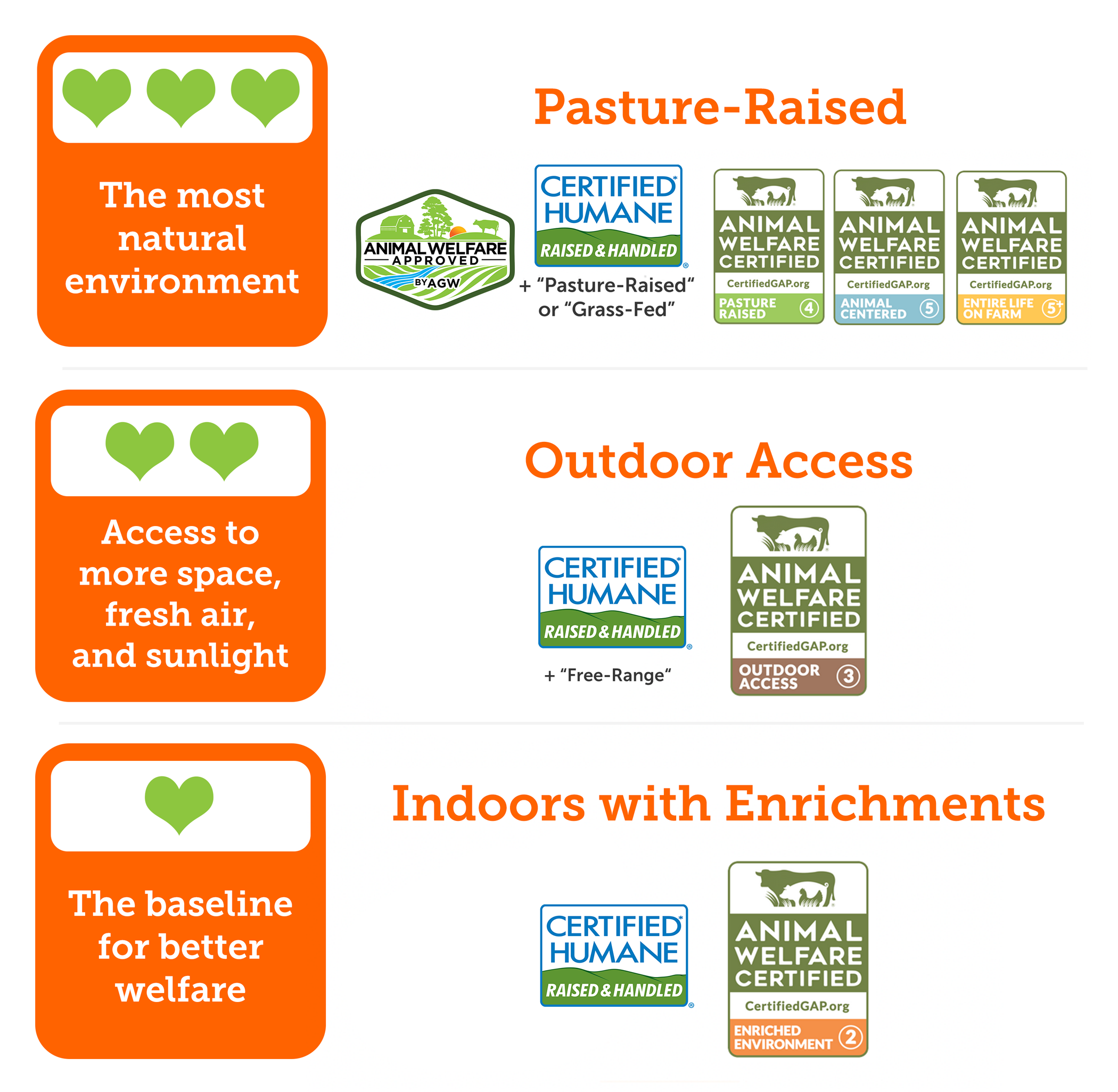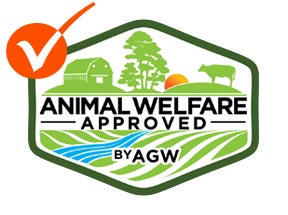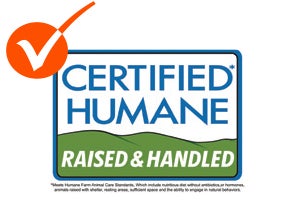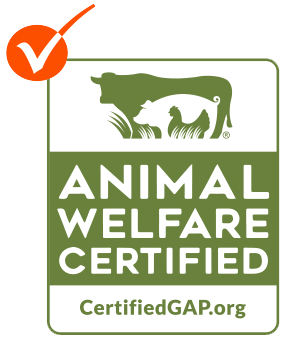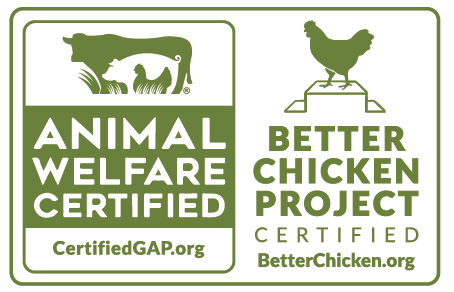Common Claims | ASPCA Recommended Certifications | Other Certifications | Further Resources
Common Claims
The terms below, which often appear on the packaging of meat, egg and dairy products, may indicate better animal welfare but lack strong standards and have no on-farm verification processes, meaning farm conditions and the treatment of animals vary widely across producers.
Certifications Recommended by the ASPCA
The ASPCA has identified three independent certification programs that ban or limit the most concerning practices animals experience on factory farms—including extreme confinement, crowding and painful physical alterations—and provide a better life for animals through their standards with compliance assessed by audits:
- Animal Welfare Approved
- Certified Humane
- Global Animal Partnership
These three certifications represent a spectrum of higher-welfare farming systems, with standards ranging from systems where animals are housed entirely indoors to systems where animals are raised out on pasture. The ASPCA considers the baseline for improving the lives of farm animals to be housing systems where animals are raised indoors, without being confined to cages, crates or tie-stalls, with more space to move and with added environmental enrichments that enable animals to carry out critical natural behaviors, like rooting, pecking or perching. Physical alterations to animals, like castration and disbudding, should not be practiced but if needed, then they should be managed to reduce suffering as much as possible. Better still, are housing systems where animals have access to at least some outdoor space that provides access to fresh air and sunlight. The best housing systems are those where animals are raised outdoors on vegetated pasture where they can carry out all their natural behaviors.
The below chart shows where the ASPCA-recommended certifications fall with respect to the spectrum of higher-welfare farming systems.
Note: Some certifications audit different types of higher-welfare farming systems or can be strengthened by the presence of additional claims on the package. Typically, certifications’ audits are annual but can vary between 12-month to18-month cycles depending on the program. Each certification has a process to handle non-conformances during audits, requiring proof of correction within a specific time frame or the farm loses its certification. Certifications may also sometimes approve farms' requests to deviate from their standards.
Neither of these processes is publicly reported.
A fully pasture-based animal welfare certification program, available only to smaller, independent farms.
Strengths: Requires continuous access to pasture or range for all animals. Feedlots and all forms of confinement, like cages, crates and tie-stalls, are prohibited, as are added hormones and subtherapeutic antibiotics, both preventative or growth-promoting. Standards extend to animals used for breeding and require higher welfare breeds of animals to be selected. Standards cover transport and slaughter.
Limitations: Compliance is assessed by auditors on-farm, except for producer groups, wherein participating brands conduct a percentage of their own audits on farms. It is not possible to determine which products are from producer group arrangements.
Focus on small farms means AWA-certified products are limited in mainstream grocery stores.
This optional, additional certification is earned by Animal Welfare Approved (AWA)-certified producers who are also verified by A Greener World for feeding their animals a 100% grass and forage diet from weaning onward. The Certified Grassfed by AGW label only applies to ruminants certified in the AWA program: beef and dairy cattle, meat and dairy sheep, meat and dairy goats, and bison.
An animal welfare certification program that includes standards for indoor housing systems with enrichments, free-range systems and pasture-based systems, available to farms of all sizes and structures. To find products that meet Certified Humane’s additional requirements for free-range, pasture-raised and grass-fed products, look for the Certified Humane logo and those respective claims on product packaging.
Strengths: If animals are raised indoors, more space, bedding and enrichment are required than is typical on industrial farms. Confining animals to cages, crates or tie-stalls is prohibited, as is giving animals added hormones and subtherapeutic antibiotics. Standards extend to transport and slaughter. Many Certified Humane brands and farms are widely available in mainstream grocery stores.
Limitations: Standards do not extend to animals used for breeding, nor do they ensure higher-welfare breeds for animals, including broiler chickens.1 Compliance is assessed by auditors on-farm, except for producer groups and beef marketing groups, wherein participating brands conduct a percentage of their own audits on farms. It is not possible to determine which products are from producer group or beef marketing group arrangements.
Global Animal Partnership® (G.A.P.)
An animal welfare certification program that utilizes a multi-level rating system where each successive step represents progressively better welfare and includes all the requirements of those below it. Lower levels apply to indoor farming systems with enrichments. The middle levels apply to free-range systems. The top levels apply to pasture-based systems. The program is available to farms of all sizes and structures.
Strengths: If animals are raised indoors, more space and enrichment or bedding are required than is typical on industrial farms. Cage and crate confinement, added hormones and subtherapeutic antibiotics are prohibited at all levels. Standards extend to animals used for breeding, and cover transport and slaughter. Compliance is assessed by auditors on every farm.
Limitations: Level 1 requires enrichment for some, but not all species. Feedlots are permitted at lower step levels. Producers can use a basic G.A.P. label without a corresponding level number on their products, making the step level difficult to identify. Standards do not ensure higher-welfare breeds — only the G.A.P. Better Chicken Project label shown below ensures higher-welfare chicken breeds are used. G.A.P. products almost exclusively found in Whole Foods Markets.
This is an additional certification available to G.A.P. animal welfare-certified chicken producers, indicating that they have chosen one of G.A.P.’s Better Chicken Project eligible breeds tied to indicators of better welfare. For chicken products that meet G.A.P.’s animal welfare standards and breed eligibility criteria, look for the combined Animal Welfare Certified and Better Chicken Project Certified label.
Check out the Shop With Your Heart Grocery List and directory of local farms to find products with an ASPCA recognized certification.
Other Certifications

An animal welfare certification program that includes standards for both indoor and free-range systems, available to farms of all sizes and structures.
Strengths: If animals are raised indoors, more space is required than is typical on industrial farms. Prohibits the use of tie-stalls and added hormones. Standards extend to transport and slaughter. Compliance is verified by auditors on farm. Many American Humane Certified brands and farms are widely available from larger retailers.
Limitations: Standards do not prohibit combination cage confinement, also known as combi cages, for laying hens, nor gestation and farrowing crates for pregnant pigs, and they don’t require enrichments. Subtherapeutic antibiotics are permitted, as well as feedlots for beef cattle. Standards do not ensure higher-welfare breeds for animals.
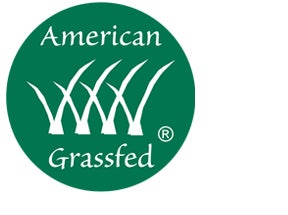
American Grassfed Association®
A grass-fed certification program for pasture-based systems, available to farms of all sizes and structures.
Strengths: Requires access to pasture for all cows, goats, sheep and pigs and a diet of 100% grasses for ruminants. Feedlots, cage and crate confinement, added hormones and subtherapeutic antibiotics are prohibited. Compliance is assessed by auditors on farm.
Limitations: Standards do not extend to transport or slaughter, nor do they cover painful procedures commonly performed on farm animals. Standards do not ensure higher-welfare breeds of animals are selected. Seasonal confinement, such as tie-stalls, of dairy cows is permitted.
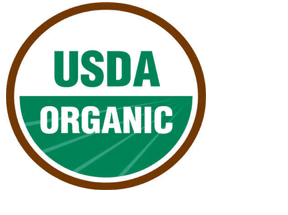
An organic certification program with standards for free-range and pasture-based systems, available to farms of all sizes and structures. USDA passed new Organic Livestock and Poultry Standards with many critical welfare improvements that go into effect in 2025 and 2029.
Strengths: Requires outdoor access for all species, though the quality of outdoor space varies between species. Added hormones and subtherapeutic antibiotics are prohibited. Starting in 2025, standards extend to transport. Compliance is assessed by auditors on every farm.
Limitations: Chickens, turkeys and laying hens will not have meaningful outdoor access until 2029. Feedlots are permitted for beef cattle. There is no minimum indoor or outdoor space requirements for pigs. Standards do not extend to breeding animals or slaughter, nor do they ensure higher-welfare breeds for animals.

An industry-created certification program that claims to address animal welfare, human health and environmental protection, but is essentially an industry marketing tool. The program is currently limited to chicken and turkey products.
Strengths: None
Limitations: This program lacks adequate animal, human or environmental health standards or oversight, despite claiming these issues as core principles. The OHC standards allow producers to choose among American Humane Certified™ certification or voluntary industry guidelines set by either the National Chicken Council or the National Turkey Federation. All three options reflect conventional, industrial practices and do not ensure higher-welfare for animals. By aligning with these programs, OHC does not require meaningful stocking density limits, lighting schedules, environmental enrichment or healthy breeds, all of which are key components of improved poultry welfare. In addition, OHC allows for routine use of medically important antibiotics for disease treatment and control, without addressing the underlying causes of disease, including poor welfare.
Directory of Local Welfare-Certified Farms
Supermarket and Restaurant Request Letter
1As of 2027, the ASPCA will only recognize chicken welfare certifications that require better breeds.
